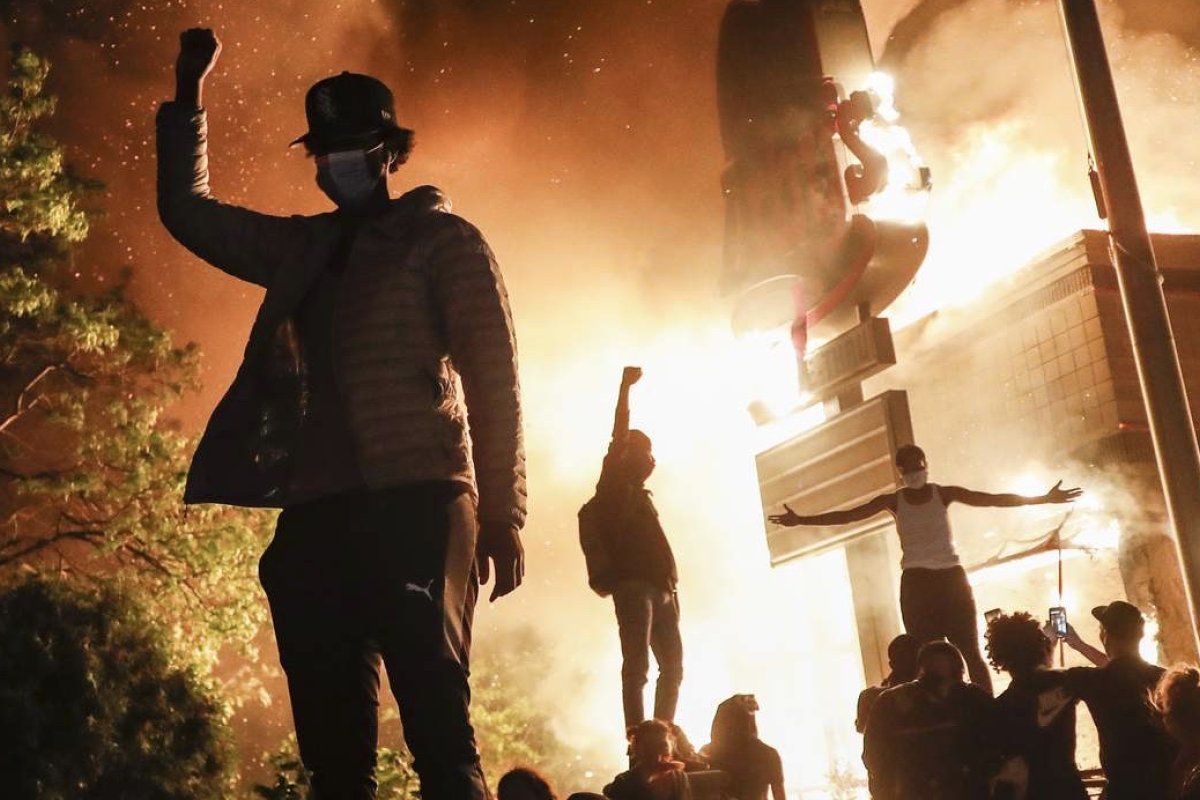
Vandals and the Hands of Christ in the World
Exploring what Christian theology might have to say about the looting and vandalism that has accompanied many protests around the country
Ed. Note: This essay is part of a special issue on the George Floyd Protests, which brings together five Divinity School students and recent graduates to comment on the role of religion in the events of the past two weeks, as well as to explore the potential contributions that we in the academic study of religion, in all our various areas of expertise, can make to the broader national conversation that is taking place at this moment. We invite you to read the other contributions to this issue:
- Letter from the Editor
- Foster J. Pinkney, Protest and the Raging Messianic
- Aneesah Ettress, We Need Art to Help Us Heal, Now More than Ever
- Nathan Hardy, Protests, Looting, and Iconoclasm
- Russell P. Johnson, Asking the Right Questions about Riots
There is a common Christian phrase that says those that do the work of God in the world are “the hands and feet of Christ.” The feet of Christ have too often had to march in America in peaceful protest against racial injustice. These last few days America has borne witness to something more shocking: the hands of Christ, scarred with the stigmata of state oppression, smashing windows, tipping cars, and even looting. Diverse sectors have condemned these acts, from black-owned businesses to the White House.
That acts of vandalism and looting can be wanton is obvious. Property crimes can devastate not only those complicit in a corrupt system, but also marginalized communities. But can economic crimes like these be tools to further the justice to which God calls nations, even in light of the legacy of peaceful protest? The answer of biblical texts is often “yes,” especially if they are part of a rejection of oppressive authority.
The story of the formerly enslaved Israelites plundering their Egyptian oppressors is one such example. Translations of Exodus 12:35-36 often describe this event euphemistically. The NRSV reads, “they had asked the Egyptians for jewelry of silver and gold, and for clothing, and the Lord had given the people favor in the sight of the Egyptians, so that they let them have what they asked.” The translation makes it seem as if the Israelites asked, and the Egyptians gave graciously. R.S. Wafula, a postcolonial theologian and social activist, argues, however, that the plunder of the Egyptians was an act of violence. Wafula explains that “the word used for the Israelite action of taking silver, gold, and clothing from the Egyptians is שָׁאַל, with the meaning of violent plunder. The Israelites, under the direction of Yahweh and supervision of Moses commit economic crimes against the Egyptians at the Egyptians’ vulnerable time” (p. 18, my emphases). The valuables were not gifts. They were loot.
While this Old Testament story has powerful implications for how we view economic crimes today, the New Testament provides perhaps the most famous instance in the Christian canon, Jesus’s overturning of the tables in the Temple described in Mark 11. Interestingly, the chapter’s connection of property damage to justice is made even more powerful by its juxtaposition with a peaceful political protest earlier in the chapter.
Mark 11 begins with what would be the analogue of a civil rights march in our own time—described in the NRSV as “Jesus’s Triumphal Entry into Jerusalem” (vv. 1–11). The story is familiar enough, reading it as an example of civil disobedience is perhaps less so. As Jesus enters Jerusalem, he inspires a peaceful protest against the oppression of Rome and colluding local authorities. The crowds call for political change, for a godly government. They waive the palm fronds like flags of civic protest, and they kneel before Christ in symbolic defiance to the banners of the state. They chant “Hosanna,” a word which J. Spencer Kennard reminds us is a cry for political salvation and should be “translated ‘Save now,’ [because] it is above all a cry to God to bring deliverance to his people from their enemies.” For Kennard, “Hosanna” is the people’s cry for Christ to lift the knee of oppression off of their necks. For many today this is a scene of immense symbolic power. But In Mark’s Gospel at least, the ruling authorities hardly bat an eye at Jesus’s protest march.
Jesus’s acts of vandalism the next day do draw their notice, however. Mark records Jesus entering the temple courts and seeing money changers and sellers of sacrificial animals. These are symbols in the text of the commodification of God and representatives of the system of oppressive local authority. Enraged, Jesus flips their tables and throws their wares to the ground. The Gospel of John’s account even has him whipping their merchandise out the door.
As the Triumphal Entry is an analogue for peaceful protest, the smashing of store windows and looting of merchandise we witness in the wake of George Floyd’s murder find an analogue in the cleansing of the Temple. As Christ’s rampage ends, he makes no apologies, even though he very likely devastated the livelihoods of the small business folk there just trying to make a living. Instead Jesus makes a point about national justice.
He says that the house of God—the Temple—the ideological embodiment of Jewish society, is to be a place of “prayer for all nations.” Ironically, prayer was never actually absent from Temple, but the presence of the money changers and their support of state oppression showed that justice was. Even with prayer happening there, even with authority figures posing there with the props of piety, the Temple had yet become a “den of robbers.” Prayer, for Christ, is more than an expression of personal faith. Prayer is an outgrowth of national and global justice. Christ destroyed property and damaged businesses to emphasize this point.
Unlike the peaceful protest of the Triumphal Entry, the ruling elites have a marked reaction to Jesus’s acts of vandalism and his corollary call to justice. Verse 18 reads, “And when the chief priests and the scribes heard it, they kept looking for a way to kill him; for they were afraid of him, because the whole crowd was spellbound by his teaching.” What do the crimes against property we’ve witnessed in the wake of the murder of George Floyd, in reaction to the murder of too many black and brown names to count, those known and unknown, mean for us, individually and as a nation? Are we the pharisees who immediately rush to condemn them and then kill the Christ, or will we be like the crowds left “spellbound,” instructed and transformed by them?
Image: Protestors demonstrate outside of a burning Arby's restaurant, Friday, May 29, 2020, in Minneapolis. (Photo Credit: John Minchillo | AP)
Sightings is edited by Joel Brown, a PhD Candidate in Religions in the Americas at the Divinity School. Sign up here to receive Sightings via email. You can also follow us on Facebook and Twitter. The views and opinions expressed in this article are those of the author and do not necessarily reflect the position of the Marty Center or its editor.


